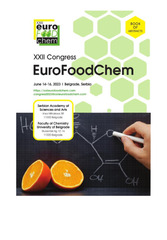Приказ основних података о документу
Chemical composition, antioxidant properties, and in vitro digestibility of flour and ground hulls of differently coloured oat varieties
| dc.creator | Nikolić, Valentina | |
| dc.creator | Žilić, Slađana | |
| dc.creator | Simić, Marijana | |
| dc.creator | Kandić, Vesna | |
| dc.creator | Sarić, Beka | |
| dc.creator | Milovanović, Danka | |
| dc.creator | Jovanović, Snežana | |
| dc.date.accessioned | 2023-10-16T07:04:02Z | |
| dc.date.available | 2023-10-16T07:04:02Z | |
| dc.date.issued | 2023 | |
| dc.identifier.isbn | 978-86-7132-083-2 | |
| dc.identifier.uri | http://rik.mrizp.rs/handle/123456789/1179 | |
| dc.description.abstract | Whole grain cereals are regarded as key components of nutrition due to their health-promoting properties. Oats (Avena sativa L.) are naturally gluten-free cereals suited for the gluten-intolerant and individuals with celiac disease. Oats are mostly utilized as flour or rolled oats in the food sector. Oat flour is produced by milling oat groats or flakes, and it is frequently used as whole-grain flour. The inedible outer hull of the oat grain is typically removed during harvest and processing. The hull typically makes up 25–30% of the kernel weight in hulled oats, with minor fluctuation across genotypes. Oats are also high in dietary fibre, notably β-glucans, which have been shown to provide medical benefits such as lowering cholesterol, slowing glucose uptake, and lowering plasma insulin levels [1,2]. Furthermore, phenolic acids, flavonoids, carotenoids, vitamin E, and phytosterols are plentiful in oats [3,4]. Oat hull is high in fibre and low in protein, which lowers the amount of energy that can be extracted from the kernel. Thus, the use of hulled oats in diets for pigs and poultry is severely constrained, however, ruminant animals can profit from oats' high levels of fat and fibre compared to other cereal grains. Oats are currently sent to mills as blends of many oat cultivars with varying quality characteristics, which presents a challenge for the food industry because it makes it more difficult to forecast the quality of the finished product. This study aimed to examine the nutritional potentials of the whole grain oat flour and hulls of three oat genotypes with different hull colours: yellow, brown, and black. Ground oat grains and oat hulls were investigated for their levels of total phenolic compounds, phenolic acids, β-glucans, antioxidant capacity, and in vitro digestibility. An in vitro multi-step digestion method was used to determine the potential digestibility of the oat samples for human consumption as a function of processing variables. The oral, gastric, duodenal, and colon phases of the method proposed by Papillo et al. [5] and modified by Hamzalıoğlu and Gökmen [6] were carried out without attempting to closely resemble gastrointestinal digestion. Significant variations were found amongst the analysed samples, particularly when comparing parameter values found in the hulls to those found in the whole-grain flour. In comparison to flour (841.89-982.08 μg GAE/g d.m.), oat hulls had more total phenolic compounds (11320.11-24352.48 μg GAE/g d.m.), as well as the phenolic acids: p-coumaric, ferulic, isoferulic, vanillic, and syringic acid. Ferulic acid was predominant in both the whole grain flour (395.88-589.14 μg/g d.m.) and the hulls (4987.02-13794.82 μg/g d.m.). The antioxidant capacity was higher in oat hulls, ranging from 42.31 mmol Trolox/ kg d.m., in yellow hulls to 53.16 mmol Trolox/kg d.m. in brown hulls, and from 22.61 mmol Trolox/kg d.m. in black grain, to 25.06 mmol Trolox/kg d.m. in brown whole-grain flour. On the other hand, only 0.03–0.06% of the β-glucan content was found in the hulls, while it ranged from 4.07% to 5.33% in the whole-grain oat flour samples. The absence of anthocyanins and proanthocyanidins suggests that these coloured bioactive compounds are not where the oat variants' colour comes from. The in vitro digestibility of brown whole-grain flour was the highest (48.24%), followed by black (44.72%) and yellow oat flour (44.54%). The degradability of the ground oat hulls was significantly lower, considering that the in vitro digestibility ranged from 12.02% in the black genotype to 16.69% in the brown genotype. The examined oat genotypes manifested a significant potential for use as high-quality food and feed ingredients with nutritional and health-promoting advantages. | sr |
| dc.language.iso | en | sr |
| dc.publisher | Beograd : Srpsko hemijsko društvo | sr |
| dc.relation | info:eu-repo/grantAgreement/MESTD/inst-2020/200040/RS// | sr |
| dc.rights | openAccess | sr |
| dc.rights.uri | https://creativecommons.org/licenses/by/4.0/ | |
| dc.source | XXII Congress, European Food Chemistry – EuroFoodChem, June 14-16, Belgrade Serbia, Book of Abstracts | sr |
| dc.subject | oats | sr |
| dc.subject | fiber | sr |
| dc.subject | in vitro digestibility | sr |
| dc.title | Chemical composition, antioxidant properties, and in vitro digestibility of flour and ground hulls of differently coloured oat varieties | sr |
| dc.type | conferenceObject | sr |
| dc.rights.license | BY | sr |
| dc.citation.spage | 159 | |
| dc.identifier.fulltext | http://rik.mrizp.rs/bitstream/id/6308/bitstream_6255-159.pdf | |
| dc.identifier.rcub | https://hdl.handle.net/21.15107/rcub_rik_1179 | |
| dc.type.version | publishedVersion | sr |


